The phone call usually sounds something like this (this one came from Mechanicsburg, PA): “Hi – We did not notice this when we first moved in, but our bathroom walls seem to be sweating out something sticky. At first we thought it was just condensation, but one day we tried to wipe it off and realized there was something coming out of the paint. It is always worse after we take a shower and when it is raining or humid outside”. The bad news is that these walls will remain sticky until they are addressed. The good news is that sticky walls are a fairly easy fix once you know how to do it.
What is the cause of sticky walls in the bathroom?
Sticky walls in the bathroom are caused by one of two things almost 100% of the time, wallpaper paste/residue, or surfactant leaching.
- Wallpaper paste/residue is a little more tricky to identify because it sneaks up on you. We normally run into this with homeowners that have purchased a house within the past 12 months, and the issue was not visible at first. Most commonly, the former homeowner has taken the time to pull their custom wallpaper off the bathroom walls to make it more appealing to potential buyer (LOTS of bathrooms with wallpaper in Mechanicsburg, PA), but they stopped at this step and did not finish the job before applying a latex paint. What they did not understand is that latex paint, despite all appearances, is porous enough for moisture to pass through. Once this happens, wallpaper paste can be reactivated and leach back through the paint to the surface.
- Surfactant leaching can occur quickly, or it can sneak up on you depending on what the cause is. With surfactant leaching, some of the very ingredients in paint that make it work, actually separate and leach to the surface to the paint. This is typically moisture related, but can also occur with drastic changes in temperature. Surfactant leaching will appear as streaky runs (or sometimes spots) and can vary in color. Brown and clear are the most common colors that we have come across over our years of painting. Surfactant leaching may show up shortly after a room has been painted if the paint is not given adequate time to cure. Heavy amounts of moisture over time can also cause the paint to deteriorate slowly (Yes long shower takers, I am looking at YOU…)
Fortunately the solution for both of these sticky wall problems is the same. Start by cleaning the walls to be painted with Krud Kutter (for those of you who are environmentally conscious) or TSP (for those of you who are not). Allow walls to dry out COMPLETELY – a fan or small heater can be used to speed up the drying process. I suggest skipping the standard bonding-type primers and head straight for something more specialized. Chemistry has improved quite a bit with water-based products in recent years, and Zinsser Gardz problem surface sealer is at the top of the food chain for this issue. Don’t be fooled by the look of this product (is is translucent and dries clear), it is a workhorse and will get the job done. It is important to make sure this product has time to cure properly. The can recommends waiting 3 hours, however, I suggest letting this product set up overnight. After all, we don’t want to go through this process again!
An oil-based or shellac-based primer may also be used to seal walls after cleaning. These were our “go to” solutions for many years and served us well. However, “old school” primers present their own sets of problems. In the case of oil-based primers, they smell terrible for days and typically take much longer to dry. Shellac-based primers dry quickly, but are brittle and don’t do as well with moisture over the long haul. If you choose to go the route of using either of these products, please make sure to invest in a high quality organic vapor respirator since they are both hard on the lungs.
Lastly, make sure to purchase a high-quality paint in either an eggshell finish that is suitable for bathrooms. Most paint companies make their own version of a bath and spa type paint. These work great but are not always necessary since most modern paints have resistance to moisture and mildicides. Check with your salesman if you aren’t sure what the right product is for the job (and if you are lucky they may actually know the answer).
The other part of this equation, the part that gets ignored regularly, is to make sure you let the paint cure for as long as possible before taking showers. While it is hard to get a straight answer on how long is the “right time”, most paints are technically curing for 15-30 days. No matter how nicely I say it, our customers tend to really, REALLY dislike being asked to shower elsewhere for 2 weeks. But I do recommend waiting at least this long if there is another shower in the house. Again, using a heater and fan will expedite this process.
BONUS TIP: Even the best paints applied over a perfectly sealed surface can still break down over time. Make sure to always use the bathroom fan anytime hot water is being used. If you don’t have one, consider installing one for longevity of your paint job. Even better, install a timer on the bathroom fan and allow it to run for 15 minutes after you are done in the shower.
Do you recommend hiring a pro for this job?
While the bathrooms are typically small and do not seem like much work, they can be very time consuming due to the high mount of intricate brushwork and cramped space. Another consideration that customers often comment on – “I’m so sorry you have to paint behind the toilet, that is so gross”. Just remember you are signing up to do all of these things x 3 between the prime coat and 2 top coats. If you DO decide to attempt this project on your own, make sure to wear an organic vapor respirator since bathrooms are confined spaces! The paper kind are great for filtering particles, but come up short with vapors associated with these products.
We hope you have found our blog post useful for helping to solve the issue of sticky bathroom walls. For more articles and tips please find and like our Facebook page at www.facebook.com/justaddpaint For FREE online estimates, check our website www.justaddpaint.net/contact-us.
Have housepainters coming soon? You may find this helpful… https://www.justaddpaint.net/how-to-prepare-your-house-for-interior-painting-in-mechanicsburg
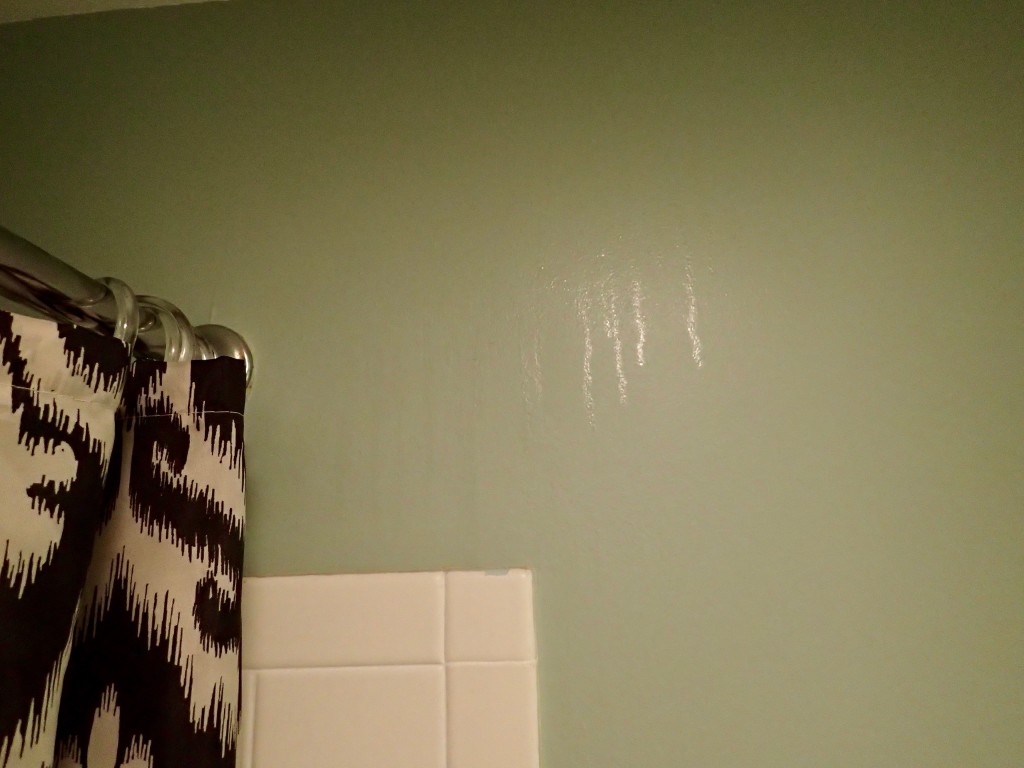
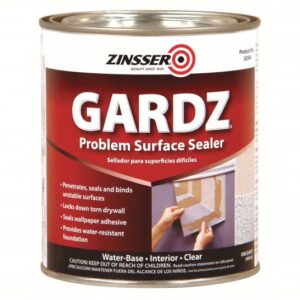
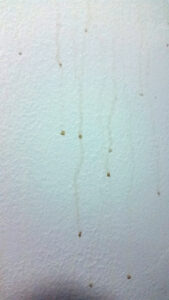

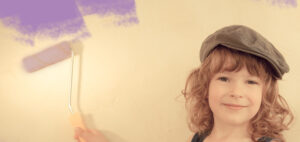

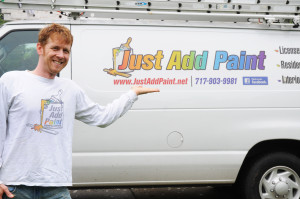
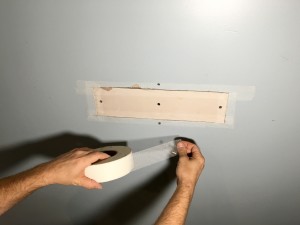
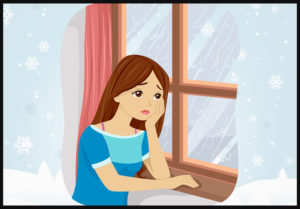
Thank you for the great article as I’m about to repaint our bathroom ceiling, walls and cabinets..
Any other possible causes for this? I’m the original owner of this home, never used wall paper in the bathroom and am not a smoker. My issue looks exactly like this however is more obvious because my wall paint color is maroon. Some of these “condensation drip” type marks are over a foot long and start from the ceiling with sometimes 6-9 inches no longer drips but are sticky/wet as a whole
Hi Adam – Yes. The other most common issue is surfactant leaching caused by using the shower or tub too soon after painting. Particularly with deep base colors, you will need to wait several days for the paint to fully cure. Maybe even longer depending on temperature and humidity. Our regional rep from PPG suggests cleaning with TSP, rinsing, allow to thoroughly dry, and then repaint. I agree with this suggestion other than I would add the step of priming with either an oil-based or shellac-based primer. Also to aid in drying, keep a fan running in the bathroom and/or a space heater. Hope this helps!!!
Thank you so much for this article! I live in a rental home that has this problem. They won’t repaint the bathrooms, but I want to get rid of this stuff! Will the Krud Kutter damage the existing paint job? The color is a darker gray with a blue tint. Thanks again for being so informative!
Hi Renee – In general, we have found Krud Kutter to be one of the safest products our there for wall cleaning. However, beware if you have flat paint without any sheen on it, as this can absorb even the safest of cleaners. As long as you have a little sheen on the walls I would suggest diluting the Krud Kutter at a ratio of 4 or 5:1 to be safe, and try cleaning with a microfiber rag. Start in an inconspicuous spot to make sure it will not damage the existing paint (if it does you most likely have a flat or low grade paint on the wall). If this does not do the trick and you can see that the Krud Kutter is not discoloring the walls you can add a little more Krud Kutter to the solution. I hope this helps, sticky walls are no fun!